The Idiot, who is returning to Antibes on the French Riviera for the first time since the pandemic hit, will repeat the first steps he took when he began his 20-year-walk around the Mediterranean Sea on January 1, 1998.
Here’s what his first steps looked like twenty-three years ago — and what they’ll probably look like today.
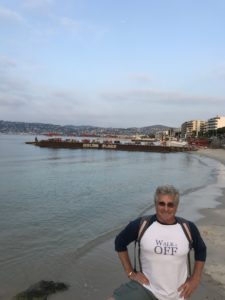
The Idiot is returning to the spot in the south of France where he kicked off his walk around the Mediterranean Sea in Antibes on January 1, 1998.
The Idiot’s first post-pandemic stroll in France will kick off, as did his outing 23 years ago, with a visit to the Picasso Museum in Antibes.
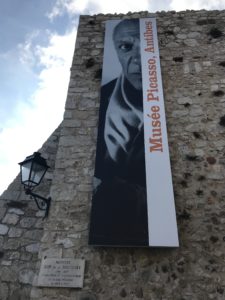
“I’m eager to get going on New Year’s Eve (1997), the day before my Mediterranean journey begins, when I visit the Picasso Museum perched on the weathered stone ramparts overlooking the sea in Antibes in the south of France.” — Extract from “The Idiot and the Odyssey: Walking the Mediterranean” published in 2008.

“I gaze at ‘Ulysses and the Sirens’, Pablo Picasso’s vivid 12-foot high allegorical painting from 1947 that features my cunning and crafty hero bound to the spar of his ship as he withstands the mind-blowing song of the tempting Sirens. Picasso’s kaleidoscopic portrayal of misshaped mountains, fish and sea maidens pointedly reminds me that this expedition has been beckoning since I was a kid…About to set off on a journey inspired by a multitude of myths and a literary white rabbit that will lead me into a Mediterranean wonderland, I imagine myself a contemporary Odysseus tied to the mast as my sailors, wax in their ears, row past seductive Sirens to meet, as Homer recounted, the vagaries of the ‘Ocean, who is the source of all.’ Incidentally, at 50 I’m a bit older than Kirk Douglas was when he portrayed Ulysses in a 1955 film.” — Extract from “The Idiot and the Odyssey: Walking the Mediterranean” published in 2008.

“Staring out the museum window over the bright azure sea takes me far beyond the seemingly infinite sapphire horizon. My mind’s eye transports me first to the cliff-hanging village of Bonifacio on the southern tip of Corsica where I once admired the purported remains of the ‘Lady of Bonifacio’ dating from 6570 BC. Then I mentally dart across the sea to Carthage, the seaside city-state in contemporary Tunisia founded by Queen Dido in 814 BC that’s one of my preferred archaeological sites on that country’s 1300-kilometre coastline. Finally I time travel to a hotel beneath Mount Etna in Sicily where my daughter Sonia was conceived in 1981.” — Extract from “The Idiot and the Odyssey: Walking the Mediterranean” published in 2008.
The first steps along the Antibes ramparts took, then and now, The Idiot past the city’s archeological museum to hike around the Cap d’Antibes.

“Although the Mediterranean probably does not have a beginning or an end, it seems appropriate that the Côte d’Azur city of Antibes, a cradle of Greek civilisation in the fourth century BC and just a few minutes from my home, is my starting point.
One of the largest pleasure boating harbours on the Mediterranean, Antibes is known for the dolphins and sharks at its Marineland, its flourishing flower production, the Bacon (pronounced Bah-cone) fish restaurant and, for me at least, the 50-metre pool where I’ve been swimming with a masters team for two decades.” — Extract from “The Idiot and the Odyssey: Walking the Mediterranean” published in 2008.
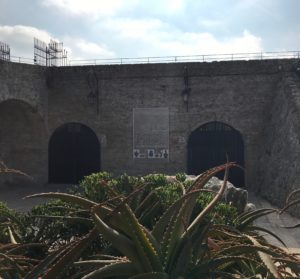
“Near the Picasso museum, where the artist painted for a few months in the late 1940s, is the town’s archaeological museum. Its plethora of ancient treasures includes the reconstruction of a Roman ship as well as Etruscan, Greek and Roman amphorae and artefacts that illustrate a whopping 4000 years of history. A visit there excites me about the rainbow of religions, languages, literature, history, cultures, cuisine, climate and countryside that I’ll encounter on the MedTrek.” — Extract from “The Idiot and the Odyssey: Walking the Mediterranean” published in 2008.
The Idiot, revealing a bit of nostalgia for the place he lived and raised his children for twenty years, may even backtrack to the pool where he began swimming with a masters’ team in 1984.

“Incidentally, my aquatic teammates know that I’m a sprinter rather than a long-distance kind of guy and are a bit sceptical about my ambitious project. During one of our recent post-workout lunches they snickered when I mentioned, over salades Niçoises, that the journey will instruct me about balance, clarity, serenity, a higher power, good and evil, sun block, global warming and doing nothing. But one of them cut me a little slack.
‘Well, at least you’re not swimming around it!’ said Des Baum from South Africa. ‘And fortunately it’s not the Pacific!'” — Extract from “The Idiot and the Odyssey: Walking the Mediterranean” published in 2008.
The walk around the Cap d’Antibes has been vastly improved during the past twenty-three years and this time The Idiot probably won’t fall and lose his pedometer, which he did just over two decades ago.
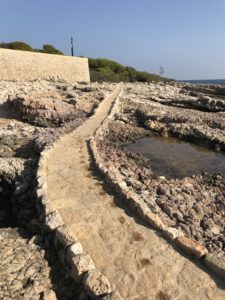
“As we begin to round the rocky Cap d’Antibes, there’s a lot less litter. I’m not worrying about making good time, walking a particular distance or even breathing properly. The pace, I figure, will take a few days to establish. Today I’ll just try to focus on taking it easy and making some interesting detours.” — Extract from “The Idiot and the Odyssey: Walking the Mediterranean” published in 2008.
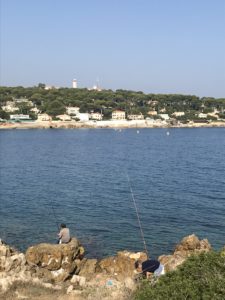
“Delphyne proclaims that the distinctive blue-green colour of the water is another good omen and stops at a bench by the sea, she says, to ‘meditate myself into the right frame of mind for the MedTrek’. She wants 30 minutes of ‘quiet time’, which gives Bogart and me a chance to climb to the Garoupe lighthouse, the most powerful beacon on the coast with a beam that shoots out 40 miles.
Olive-black clouds obscure Corsica, the island that de Maupassant called ‘a mountain in the middle of the sea’ where some claim Homer’s savage and cannibal Laestrygones giants once lived. Near the lighthouse, a small chapel called the Sanctuary de la Garoupe is open and, passing between two wrought-iron gates, we step inside. Standing amidst frescoes and dozens of votive offerings, including oddities like a tattered black sailor’s cap and a broken walking stick, I light a candle at the wooden statue of Our Lady of Safe Homecoming. This Black Madonna is known as the patron saint of sailors. Hopefully, she might look especially kindly on seaside walkers.” — Extract from “The Idiot and the Odyssey: Walking the Mediterranean” published in 2008.

“In the distance, the snow-covered Alpes-Maritimes look calm and pristine as seven cormorants fly in formation above us at the roundabout near the Josse Hôtel. Delphyne insists they are a good omen. She has obviously read her Homer because in The Odyssey a compassionate sea nymph appears on Odysseus’ raft in the form of a cormorant.
‘These birds are descendants of Odysseus’s helpful feathered friend,” Delphyne tells me.'” — Extract from “The Idiot and the Odyssey: Walking the Mediterranean” published in 2008.
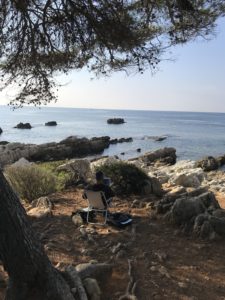
An artist on the Cap d’Antibes in 2017.
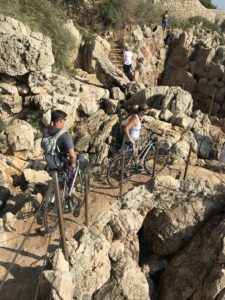
Even The Idiot was never stupid enough to take a bike on the unbikeable path around the Cap d’Antibes.
“What guidebook did you read?” he asked these two Americans in 2017.
This week’s walk will take The Idiot past La Garoupe Beach and to his latest beach du jour before he’ll a modernized and relocated plaque to Jules Verne, the Eden Roc Hotel and the former Naval and Napoleonic Museum, which was relocated to downtown Antibes a few years ago.
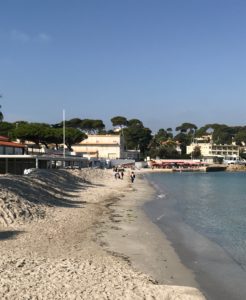
“A lone male swimmer is preparing to wade out into the dark, uninviting water at La Garoupe beach, where Gerald and Sara Murphy used to rake the sand and bring their compatriots, the F. Scott Fitzgeralds and the Ernest Hemingways, for dips back in the 1920s.
Fitzgerald, in Tender Is The Night, described ‘the ghostly wash of the Mediterranean’ and, perhaps imitating Homer, characterised the sea ‘as mysteriously coloured as agates and carnelians of childhood, green as green milk, blue as laundry water, wine dark’.” — Extract from “The Idiot and the Odyssey: Walking the Mediterranean” published in 2008.

A new addition to the path around the Cap d’Antibes will take The Idiot past a beach that wasn’t accessible to hikers 23 years ago.

“The hotel’s equally outrageous security fence and a sign declaring Propriété Privée (‘No Trespassing’) force us to hike out to the street where we stumble on a bronze plaque, half hidden by a hedge. It proclaims, in French, that Jules Verne once lived and wrote here. This, I tell Delphyne, is what makes walking different from other modes of travel. I must have driven and jogged by this spot dozens of times and never noticed the monument to one of my literary heroes. I’ve always loved the magical and mythic worlds Verne created in Mysterious Island and Twenty Thousand Leagues Under the Sea. But I had no clue, until now, that he’d lived here. My mood brightens immediately.” — Extract from “The Idiot and the Odyssey: Walking the Mediterranean” published in 2008.

“We pass the front gates leading into the opulent Eden Roc and run into the Naval and Napoleonic Museum located in a former battery called Le Grillon. There are two giant Louis XIV bronze cannon at the entrance. Inside are scale models of sailing ships and soldiers, a bust of Napoleon sculpted in 1810 and even a document bearing Bonaparte’s signature.” — Extract from “The Idiot and the Odyssey: Walking the Mediterranean” published in 2008.

Unlike twenty years ago, property signs since that time were often in English and Russian.
The Idiot’s first post-pandemic day hike will conclude with a saunter into Juan-les-Pins where he’ll have a seaside coffee and reflect on the past and present vicissitudes of life.
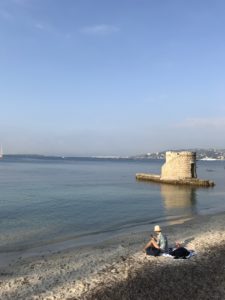
“Not that I’m travelling particularly light. I’m carrying a spare pair of shoes, small first-aid kit, flashlight, tiny collapsible umbrella, baseball cap, poncho, a moderately detailed local map, gloves, a swimming suit, sun block, some extra clothes, the authoritative Michelin Green guide to the French Riviera, the Kazantzakis book and another version of The Odyssey by Derek Walcott, a collection of old photos of Cannes, lots of water and some tangerines. I’m so certain about the direction I’m going that I didn’t bring a compass and don’t plan on carrying camping equipment until I get beyond civilisation.” — Extract from “The Idiot and the Odyssey: Walking the Mediterranean” published in 2008.
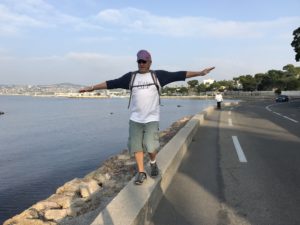
Walking the Mediterranean can often be a balancing act.
(Photo: Liz Chapin)

“Trying to distract Delphyne from her earthly pain, I tell her I found myself at the annual summer jazz festival here in 1970, when I’d finished hitchhiking around Spain and Portugal and thumbed a ride to Cannes. Hundreds of us were standing below the window of the once-elegant Belles Rives hotel chastising Aretha Franklin for not coming back on stage for an encore.
“Give us some R-E-S-P-E-C-T,” we chanted over and over, as though we were passionately protesting the Vietnam War. But she didn’t.” — Extract from “The Idiot and the Odyssey: Walking the Mediterranean” published in 2008.
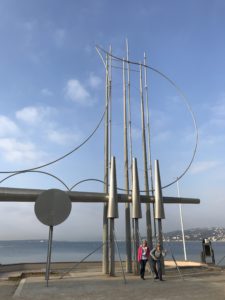
This sculpture did not adorn the site of the annual jazz festival in Juan-les-Pins twenty-three years ago.

This plaque to F. Scott Fitzgerald was not here twenty-three years ago.
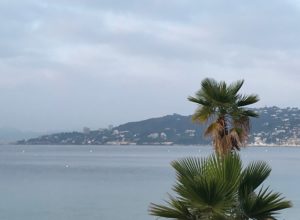
“From our bench, we can see road signs pointing north towards Vallauris, the centre of pottery making on the Riviera and another place where Picasso once lived and worked; Sophia Antipolis, a forested high-tech office park that’s about a 15-minute drive from the coast; and the scented city of Grasse, the mother village of the area’s perfume industry that, with its frescoed façades and mosaic fountains, is a sweet-smelling hillside town (think Willie Wonka & the Vanilla Factory) full of flower, fruit, flea and vegetable markets. More significantly, the scenic Route Napoleon begins here, wends its way past Vallauris and fragrant Grasse, and continues through the Maritime Alps to Grenoble. Bonaparte and his armies marched north from this very spot in 1815 and today this is one potential starting point for anyone hiking from the Mediterranean to Paris, which Bogart and I did in 1991.” — Extract from “The Idiot and the Odyssey: Walking the Mediterranean” published in 2008.
To read more about it get “The Idiot and the Odyssey” trilogy of travel narratives published in 2008, 2013 and 2018 @ amazon.com.

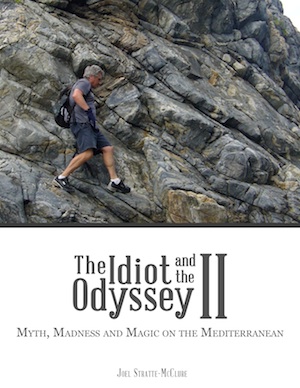


 Follow
Follow